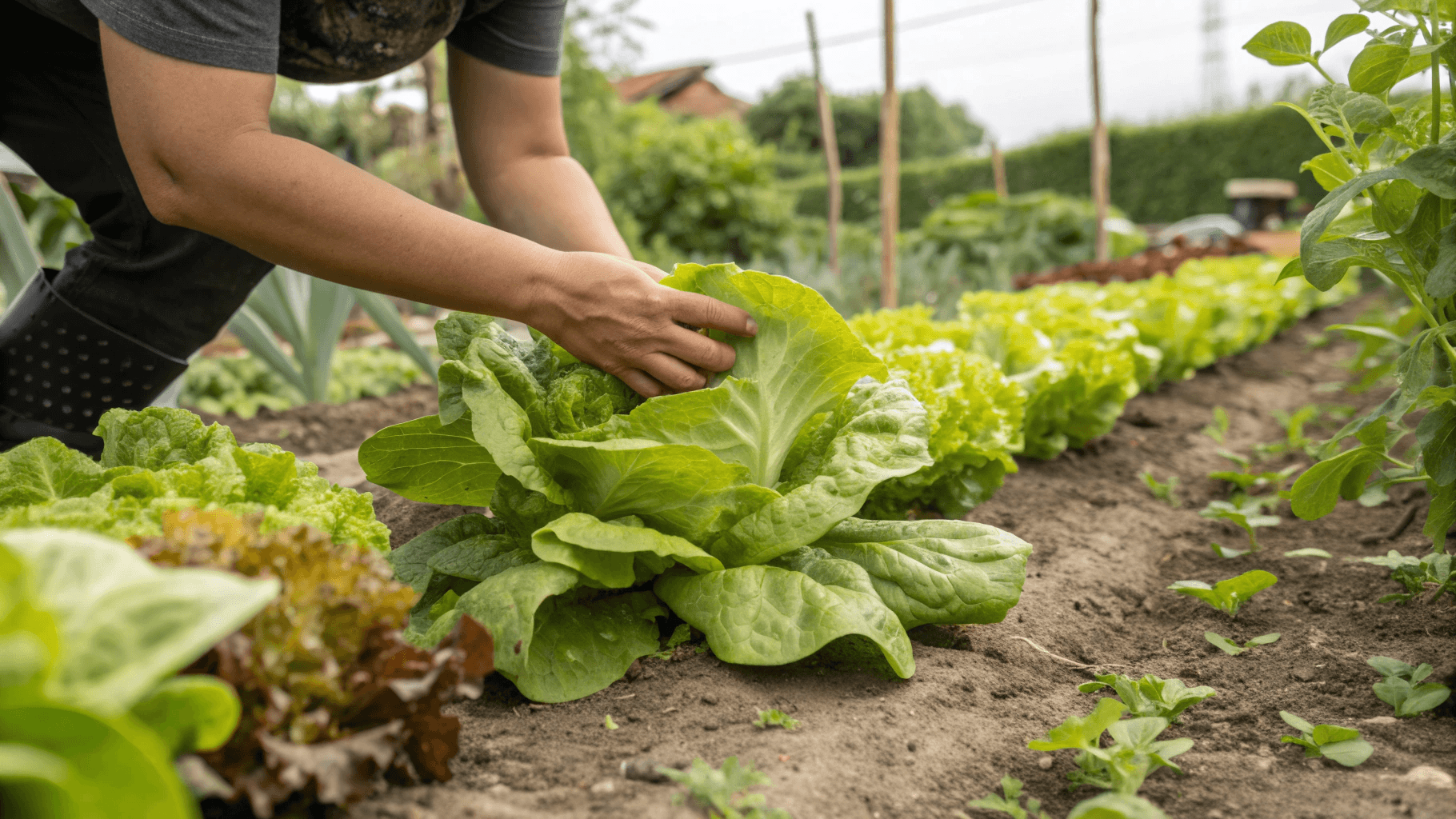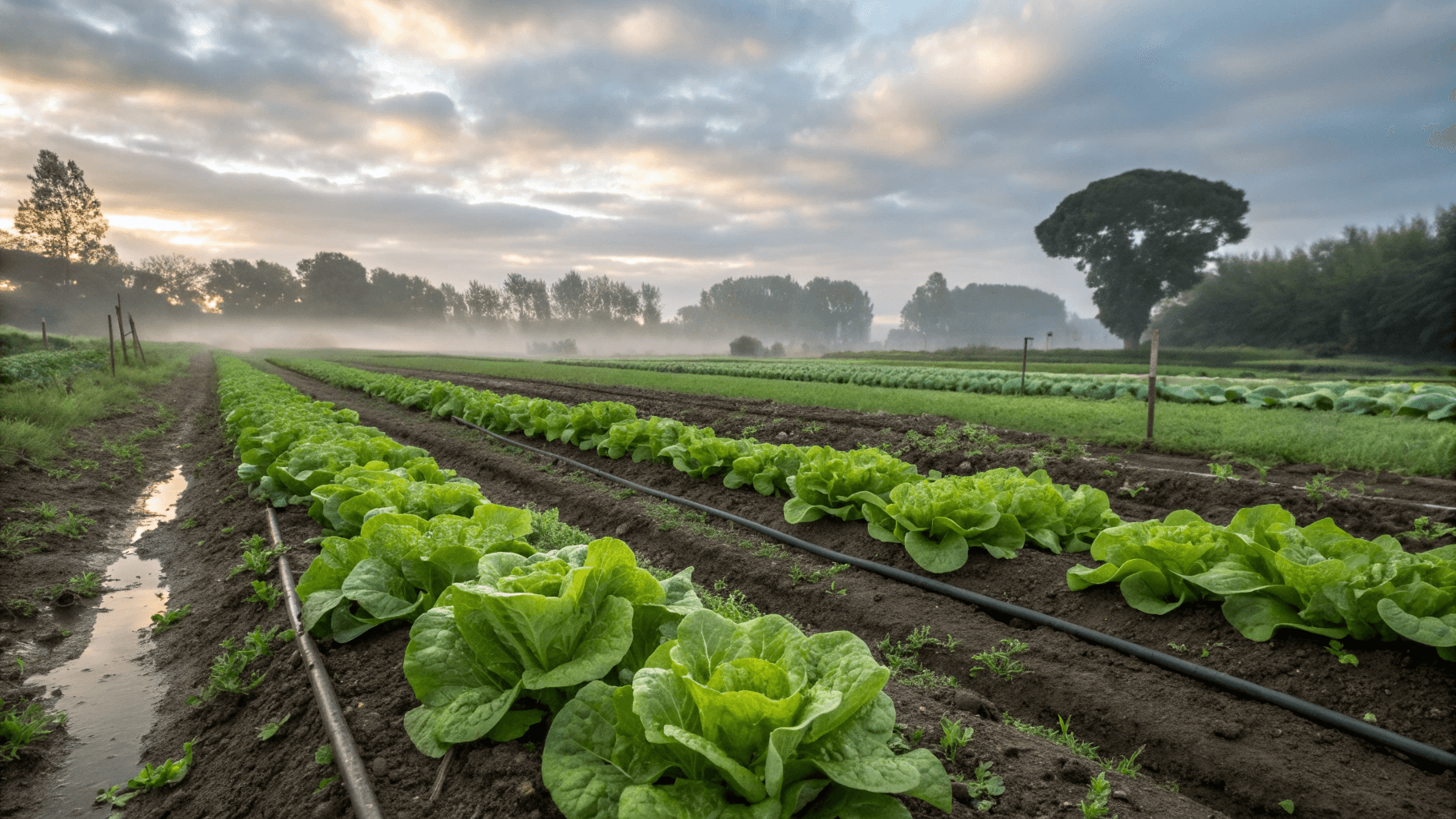How to harvest lettuce properly is one of the simplest ways to keep your garden producing fresh greens for weeks. If you’re looking for the easiest, most reliable way to get continuous lettuce from your garden, the cut-and-come-again method is the secret.
To harvest lettuce properly, cut the outer leaves a few inches above the base, leaving the crown intact so the plant keeps producing new growth.
With this simple approach, even a small garden or a few pots on a balcony can provide fresh salads for weeks or even months. The trick lies in knowing when lettuce is ready, how to cut it without stressing the plant, and how to prevent it from turning bitter as the season warms.
When Lettuce Is Ready to Harvest

Timing is everything with lettuce. Harvest too early, and you get tiny leaves with minimal flavor. Harvest too late, and you risk toughness, bitterness, or bolting (when the plant shoots up a flower stalk and stops producing edible leaves).
Here’s how to know when your lettuce is ready.
Loose-Leaf Lettuce
These are the easiest and fastest to harvest.
Look for:
- Leaves around 4-6 inches long
- A full-looking rosette
- Flexible, tender leaves when you gently bend them
Loose-leaf types grow continuously, so as soon as the leaves look “salad size,” you’re good to start picking.
Romaine (Cos) Lettuce
Romaine takes a little longer to mature and grows upright with tightly packed leaves.
It’s ready when:
- The head feels firm and elongated, about 8-10 inches tall
- Inner leaves are stacking into the characteristic romaine shape
- Outer leaves are wide and full
If the plant begins to form a central stalk (a sign it’s stretching upward), harvest immediately, it’s close to bolting.
Butterhead and Bibb Lettuce
These form soft, round heads.
They’re ready to harvest when:
- A loose “head” forms and is about the size of a small grapefruit
- Leaves feel tender but not flimsy
- The base stem begins to thicken slightly
Signs Lettuce Is Too Mature
Look out for:
- Leaves turning thicker or leathery
- A milky sap when cut (a classic bitterness warning sign)
- A rapidly rising central stalk
Once these appear, harvest ASAP to salvage flavor.
How to Harvest Lettuce
Not all lettuce varieties behave the same way. Harvesting them properly ensures better regrowth and better flavor.

Loose-Leaf Lettuce (Oakleaf, Salad Bowl, Red Leaf, etc.)
Loose-leaf varieties were practically made for cut-and-come-again harvesting.
Method:
- Pick outer leaves regularly
- Snip only what you need
- Let the inner rosette stay intact
These varieties regrow quickly and reliably, making them great for continuous salads.
Romaine Lettuce
Romaine is slightly different. Although you can use the cut-and-come-again method, many gardeners prefer one of two approaches:
Variant 1: Harvest Outer Leaves
- Cut the larger leaves from the outside
- Leave the central column to continue forming a head
- Provides steady harvests while allowing a full romaine head to eventually form
Variant 2: Cut Entire Head Above the Base
This is a great trick if you want whole romaine heads but still want regrowth.
- Cut the entire head about one inch above the soil
- Leave the stem and roots intact
- Within 7–10 days, you’ll often see small leaves growing back
The second growth is smaller but still tasty.
Butterhead Lettuce
Butterhead is more delicate and doesn’t regrow as vigorously after a full-head cut.
Method:
- Pick larger outer leaves
- Leave the center intact
- Or harvest whole heads when they reach desired size
Crisphead/Iceberg Lettuce
These are not ideal for cut-and-come-again. They form a tight head and don’t regrow well. For the iceberg, you’re better off harvesting the entire head at once.
Cut-and-Come-Again Method (Step-by-Step)
The cut-and-come-again method is popular because it’s incredibly efficient: you harvest a portion of the lettuce plant while allowing it to regrow. Instead of pulling the entire plant, you take only what you need and keep the plant alive.

Here’s the proper way to do it.
Step 1: Choose the Right Leaves
Select the outermost, largest leaves first. These are mature, flavorful, and safe to remove without harming growth.
Avoid cutting the small, tender inner leaves, they are the plant’s growing point.
Step 2: Use Clean, Sharp Tools
Clean scissors or garden snips are best.
Why?
- Clean cuts help the plant heal faster
- Dirty tools can spread fungal issues
- Tearing leaves by hand can damage the crown
Step 3: Cut 1-2 Inches Above the Crown
The crown is the central growing point at the base.
Cutting just above it:
- Prevents damage
- Encourages quick regrowth
- Reduces risk of rot
Aim for a clean cut with a slight upward angle.
Step 4: Harvest No More Than One-Third of the Plant
Removing too much at once stresses the plant and slows regrowth.
- Loose-leaf: harvest lightly every 3-5 days
- Romaine: outer-leaf harvest weekly
- Butterhead: same as romaine, but more gently
Step 5: Water and Feed After Harvest
A light watering helps the plant bounce back. If your soil is depleted, a small dose of diluted liquid fertilizer can boost regrowth.
Step 6: Repeat Continuously
Under good conditions, lettuce can regrow 3-6 times or more. This method is especially effective in cool climates or during spring and fall.
How to Avoid Bitter Leaves While Harvesting

Lettuce is famous for turning bitter as temperatures rise. Fortunately, most bitterness can be prevented with a few smart techniques during harvest.
1. Harvest Early in the Morning
Morning-picked lettuce contains:
- Higher water content
- Lower latex concentration
- A sweeter, crisper texture
As the day gets hot, sugars convert and bitterness increases.
2. Keep Plants Cool
Lettuce thrives in temperatures 45-75°F (7-24°C).
To avoid bitterness:
- Provide partial shade in afternoon heat
- Use shade cloth if needed
- Mulch to keep roots cool
3. Harvest Before Bolting
Bolting is a major cause of bitterness. If you see bolting, harvest immediately, even if the head isn’t perfect.
Signs include:
- A tall central stalk
- Rapid upward growth
- Smaller inner leaves
4. Water Consistently
Lettuce becomes bitter when stressed, especially during dry spells. Keep soil lightly moist but not soggy.
5. Remove Bitter Latex
If a leaf releases milky sap, it may taste bitter.
- Soak leaves in cold water with a pinch of salt for 10-15 minutes
- Rinse and pat dry
This often improves flavor significantly.
How to Store Fresh Lettuce After Harvesting
Freshly picked lettuce is crisp, tender, and full of moisture, but it wilts fast if not stored properly. Follow these steps to keep it fresh for up to 7-10 days.
1. Don’t Wash Until You’re Ready to Use It
Moisture causes early spoilage. If you must wash it, dry it extremely well with a salad spinner.
2. Remove Damaged or Old Leaves
Start by removing:
- Yellowed leaves
- Bruised or insect-bitten parts
- Tough stems if desired
This prevents rot from spreading.
3. Store in an Airtight Container With Dry Paper Towels
A container or zip bag works great.
- Place a dry paper towel inside to absorb moisture
- Keep excess air out
- Replace the towel every few days if it becomes damp
4. Keep at the Right Refrigerator Temperature
Store at:
- 34-40°F (1-4°C)
- In the crisper drawer for optimal humidity
5. For Washed Lettuce: Store Lightly Damp
If you pre-wash and dry with a spinner:
- Store while slightly damp, not wet
- Dampness helps keep the leaves hydrated
6. Revive Wilted Lettuce
If your lettuce wilts:
- Soak in ice water for 5-10 minutes
- Spin dry
- Use immediately
The shock of cold water helps restore crispness.
Conclusion
Harvesting lettuce properly isn’t hard. Once you understand the rhythm, your plants can provide fresh greens for weeks on end. The cut-and-come-again method is the easiest way to keep your garden productive without constantly replanting.
Whether you’re growing loose-leaf varieties for quick salads or romaine for crunchy Caesar bowls, the same rule applies: give the plant what it needs, harvest gently and regularly, and it will reward you with continuous growth.
With just a little attention to timing and technique, your homegrown lettuce will stay fresher, sweeter, and more satisfying than anything you will find at a store.
Happy harvesting!


 ChatGPT
ChatGPT
 Perplexity
Perplexity
 Claude
Claude

Leave a Reply